Epidemiological and molecular characteristics of emergent dengue virus in Yunnan Province near the China-Myanmar-Laos border, 2013-2015
- PMID: 28482813
- PMCID: PMC5422898
- DOI: 10.1186/s12879-017-2401-1
Epidemiological and molecular characteristics of emergent dengue virus in Yunnan Province near the China-Myanmar-Laos border, 2013-2015
Abstract
Background: Yunnan Province is located in southwestern China and neighbors the Southeast Asian countries, all of which are dengue-endemic areas. In 2000-2013, sporadic imported cases of dengue fever (DF) were reported almost annually in Yunnan Province. During 2013-2015, we confirmed that a large-scale indigenous DF outbreak emerged in cities of Yunnan Province near the China-Myanmar-Laos border.
Methods: Epidemiological characteristics of DF in Yunnan Province during 2013-2015 were evaluated by retrospective analysis. A total of 232 dengue virus (DENV)-positive sera were randomly collected for sequence analysis of the capsid/premembrane region of DENV from patients with DF in Yunnan Province. The envelope gene of DENV isolates was also amplified and sequenced. Phylogenetic analyses were performed using the neighbor-joining method with the Tajima-Nei model.
Results: Phylogenetically, all DENV-positive samples could be classified into DENV-1 genotype I and DENV-2 Asian I genotype during 2013-2015 and DENV-4 genotype I in 2015 from Ruili City; and DENV-3 genotype II in 2013 and DENV-2 Cosmopolitan genotype in 2015 from Xishuangbanna Prefecture.
Conclusions: Our results indicated that imported DF from patients from Laos and Myanmar was the primary cause of the DF epidemic in Yunnan Province. Additionally, DENV strains of all four serotypes were identified in indigenous cases in Yunnan Province during the same time period, while the dengue epidemic pattern observed in southwestern Yunnan showed characteristics of a hypoendemic nature: circulation of DENV-1 and DENV-2 over consecutive years.
Keywords: Dengue fever; Dengue virus; E gene; Homology; Molecular epidemiology; Phylogenetic analysis; Public health.
Figures
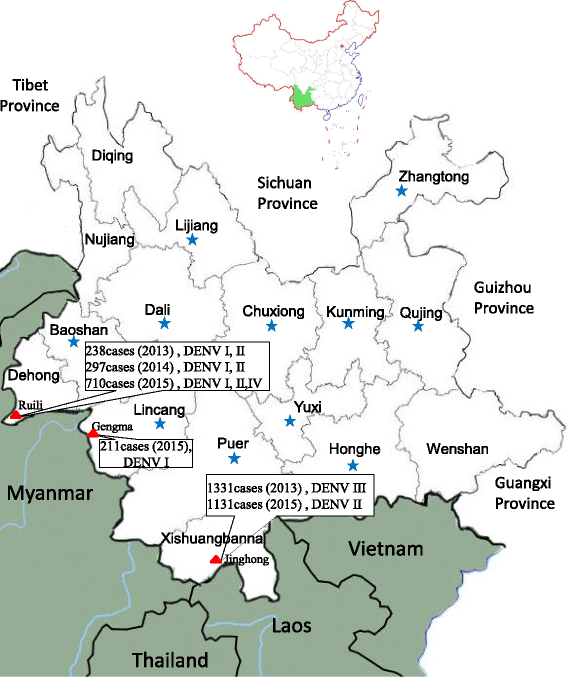
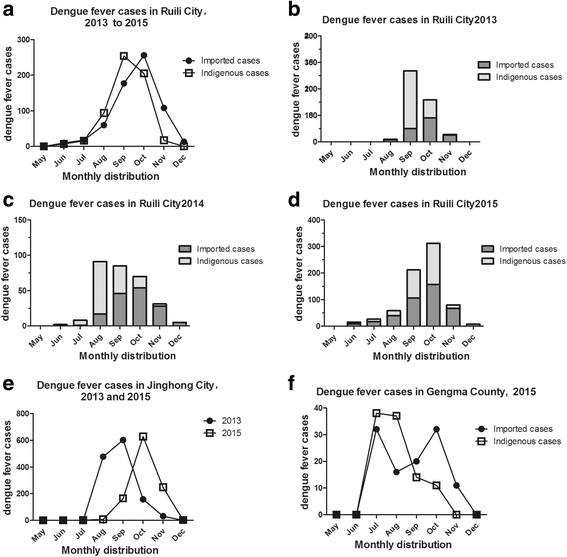
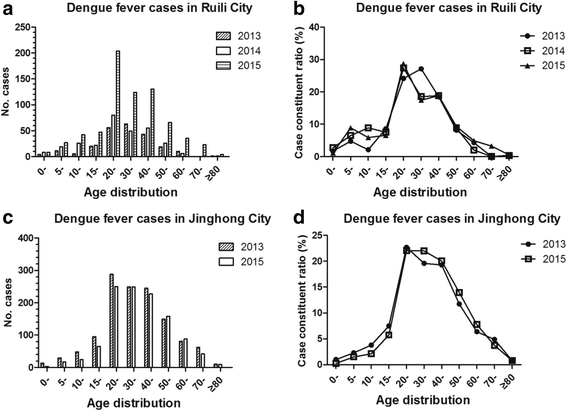
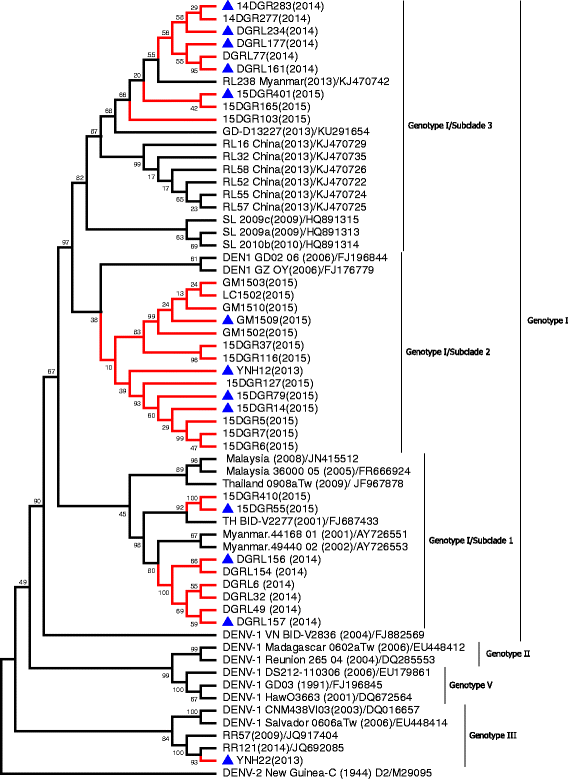

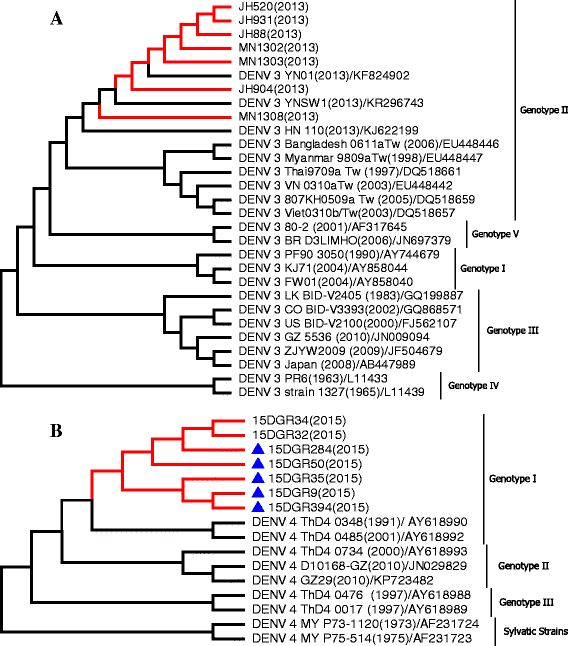
Similar articles
-
Molecular Characterization and Viral Origin of the First Dengue Outbreak in Xishuangbanna, Yunnan Province, China, 2013.Am J Trop Med Hyg. 2015 Aug;93(2):390-393. doi: 10.4269/ajtmh.14-0044. Epub 2015 Jun 15. Am J Trop Med Hyg. 2015. PMID: 26078324 Free PMC article.
-
Phylogenetic analysis of dengue virus reveals the high relatedness between imported and local strains during the 2013 dengue outbreak in Yunnan, China: a retrospective analysis.BMC Infect Dis. 2015 Mar 21;15:142. doi: 10.1186/s12879-015-0908-x. BMC Infect Dis. 2015. PMID: 25885572 Free PMC article.
-
The distinct distribution and phylogenetic characteristics of dengue virus serotypes/genotypes during the 2013 outbreak in Yunnan, China: Phylogenetic characteristics of 2013 dengue outbreak in Yunnan, China.Infect Genet Evol. 2016 Jan;37:1-7. doi: 10.1016/j.meegid.2015.10.022. Epub 2015 Oct 24. Infect Genet Evol. 2016. PMID: 26597450
-
Molecular characterization of an imported dengue virus serotype 4 isolate from Thailand.Arch Virol. 2018 Oct;163(10):2903-2906. doi: 10.1007/s00705-018-3906-7. Epub 2018 Jun 14. Arch Virol. 2018. PMID: 29948381 Review.
-
[Malaria elimination strategy and joint prevention and control of malaria across China-Myanmar border areas: an overview].Zhongguo Xue Xi Chong Bing Fang Zhi Za Zhi. 2025 Feb 27;37(1):19-23. doi: 10.16250/j.32.1915.2024281. Zhongguo Xue Xi Chong Bing Fang Zhi Za Zhi. 2025. PMID: 40235373 Review. Chinese.
Cited by
-
A time-series meta-transcriptomic analysis reveals the seasonal, host, and gender structure of mosquito viromes.Virus Evol. 2022 Feb 2;8(1):veac006. doi: 10.1093/ve/veac006. eCollection 2022. Virus Evol. 2022. PMID: 35242359 Free PMC article.
-
Full-length genome and molecular characterization of dengue virus serotype 2 isolated from an imported patient from Myanmar.Virol J. 2018 Aug 20;15(1):131. doi: 10.1186/s12985-018-1043-2. Virol J. 2018. PMID: 30126417 Free PMC article.
-
Assessing the impact of COVID-19 border restrictions on dengue transmission in Yunnan Province, China: an observational epidemiological and phylogenetic analysis.Lancet Reg Health West Pac. 2021 Aug 20;14:100259. doi: 10.1016/j.lanwpc.2021.100259. eCollection 2021 Sep. Lancet Reg Health West Pac. 2021. PMID: 34528006 Free PMC article.
-
Molecular characterization of the viral structural protein genes in the first outbreak of dengue virus type 2 in Hunan Province, inland China in 2018.BMC Infect Dis. 2021 Feb 10;21(1):166. doi: 10.1186/s12879-021-05823-3. BMC Infect Dis. 2021. PMID: 33568111 Free PMC article.
-
Epidemiological and cluster characteristics of dengue fever in Yunnan Province, Southwestern China, 2013-2023.BMC Infect Dis. 2025 Jan 21;25(1):95. doi: 10.1186/s12879-024-10403-2. BMC Infect Dis. 2025. PMID: 39838306 Free PMC article.
References
-
- WHO: Geneva. Dengue: Guidelines for Diagnosis, Treatment, Prevention and Control: New Edition. WHO and the Special Programme for Research and Training in Tropical Diseases 2009:3–16.
MeSH terms
Substances
LinkOut - more resources
Full Text Sources
Other Literature Sources
Medical
Miscellaneous

